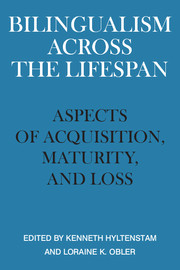Book contents
- Frontmatter
- Contents
- List of contributors
- Preface
- 1 Bilingualism across the lifespan: an introduction
- 2 Early differentiation of languages in bilingual children
- 3 Variation in children's ability to learn second languages
- 4 Idiomaticity as an indicator of second language proficiency
- 5 Prefabs, patterns and rules in interaction? Formulaic speech in adult learners' L2 Swedish
- 6 The imperfect conditional
- 7 Spanish, Japanese and Chinese speakers' acquisition of English relative clauses: new evidence for the headdirection parameter
- 8 Distinguishing language contact phenomena: evidence from Finnish–English bilingualism
- 9 The boustrophedal brain: laterality and dyslexia in bi-directional readers
- 10 Deterioration and creativity in childhood bilingualism
- 11 Crosslinguistic influence in language loss
- 12 Bilingualism in Alzheimer's dementia: two case studies
- 13 Language processing in the bilingual: evidence from language mixing
- Index
10 - Deterioration and creativity in childhood bilingualism
Published online by Cambridge University Press: 05 June 2012
- Frontmatter
- Contents
- List of contributors
- Preface
- 1 Bilingualism across the lifespan: an introduction
- 2 Early differentiation of languages in bilingual children
- 3 Variation in children's ability to learn second languages
- 4 Idiomaticity as an indicator of second language proficiency
- 5 Prefabs, patterns and rules in interaction? Formulaic speech in adult learners' L2 Swedish
- 6 The imperfect conditional
- 7 Spanish, Japanese and Chinese speakers' acquisition of English relative clauses: new evidence for the headdirection parameter
- 8 Distinguishing language contact phenomena: evidence from Finnish–English bilingualism
- 9 The boustrophedal brain: laterality and dyslexia in bi-directional readers
- 10 Deterioration and creativity in childhood bilingualism
- 11 Crosslinguistic influence in language loss
- 12 Bilingualism in Alzheimer's dementia: two case studies
- 13 Language processing in the bilingual: evidence from language mixing
- Index
Summary
Introduction
“The easiest for me is to open both faucets and let the two languages flow together.”
While this paper will discuss aspects of first language attrition in a child bilingual, the above statement by an adult bilingual in the process of losing her first language is relevant, since this paper will examine what happens when the bilingual allows both “faucets” to be open and both languages to flow together.
The problem confronting the researcher in bilingualism and first language attrition is to explain how traffic is directed when two language grammars are melded and allowed to intermix. What principles seem to be governing the movement of rules from one language to the other and what determines which factors become changed in the host language and what remains?
It will be hypothesized that the process of language attrition is motivated by a principle of REDUNDANCY REDUCTION by which the bilingual's L1 grammar is reduced to a parsimonious set of linguistic and cognitive rules.
REDUNDANCY REDUCTION PRINCIPLE: If both languages contain a rule which serves the same semantic function, that version of the rule which is formally less complex and has a wider linguistic distribution (i.e. can be used in a greater variety of linguistic environments) will replace the more complex more narrowly distributed rule.
- Type
- Chapter
- Information
- Bilingualism across the LifespanAspects of Acquisition, Maturity and Loss, pp. 173 - 184Publisher: Cambridge University PressPrint publication year: 1989
- 21
- Cited by

